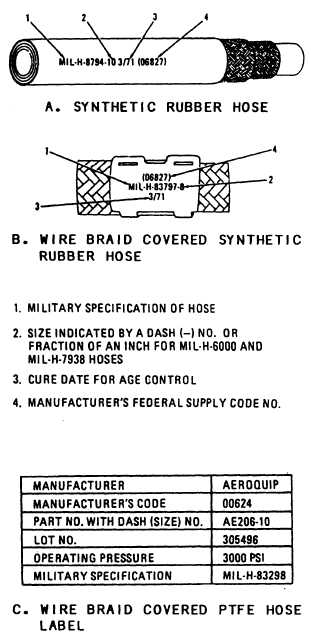Technical Directive for Piping Devices and
Flexible Hose Assemblies, NAVSEA S6430-AE-
TED-010. volume 1. provide detailed instructions
on discarding and downgrading of rubber hoses
exceeding their shelf life.
PFTE
1Q89 or
the first
Figure 5-10.—Hose identification.
1/89 means the hose was made during
quarter (1 Jan to 31 Mar) of 1989.
The cure date limits the length of time a rubber
hose can be stored, in bulk or as an assembly,
prior to being placed into service. The storage or
shelf life for rubber hose is 4 years. For the hose
manufactured in 1Q89, the storage or shelf life
will end on the 31st of March 1993. At this point,
the hose is no longer considered usable and should
be discarded or downgraded. The Aviation Hose
and Tube Manual, NAVAIR 01-1A-20, and the
5-9
PFTE hose is a flexible hose designed to meet
the requirements of higher operating pressures and
temperatures in present fluid power systems. This
type of hose is made from a chemical resin, which
is processed and extruded into a tube shaped to
a desired size. It is reinforced with one or more
layers of braided stainless-steel wire or with an
even number of spiral wrap layers with an outer
wire braid layer.
PTFE hose is unaffected by all fluids presently
used in fluid power systems. It is inert to acids,
both concentrated and diluted. Certain PFTE
hose may be used in systems where operating
temperatures range from –100°F to +500°F.
PTFE is nonflammable; however, where the
possibility of open flame exists, a special asbestos
fire sleeve should be used.
PFTE hose will not absorb moisture. This,
together with its chemical inertness and anti-
adhesive characteristics, makes it ideal for missile
fluid power systems where noncontamination and
cleanliness are essential.
In lieu of layline marking, PTFE hoses are
identified by metal or pliable plastic bands at their
ends and at intervals along their length. Figure
5-10, view C, shows a hose label for a PTFE hose.
Usually the only condition that will shorten the
life of PTFE hose is excessive temperature. For
this reason there is no manufacture date listed on
the identification tag.
APPLICATION
As mentioned earlier, flexible hose is available
in three pressure ranges: low, medium, and high.
When replacing hoses, it is important to ensure
that the replacement hose is a duplicate of the one
removed in length, OD, material, type and
contour, and associated markings. In selecting
hose, several precautions must be observed. The
selected hose must
1.
2.
be compatible with the system fluid,
have a rated pressure greater than the design
pressure of the system,

